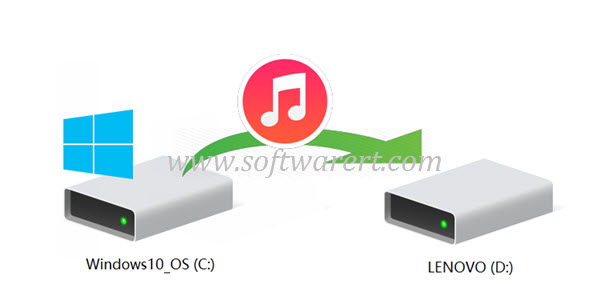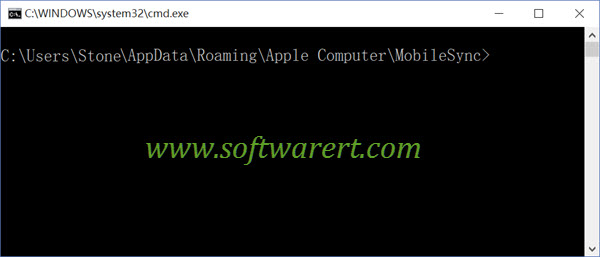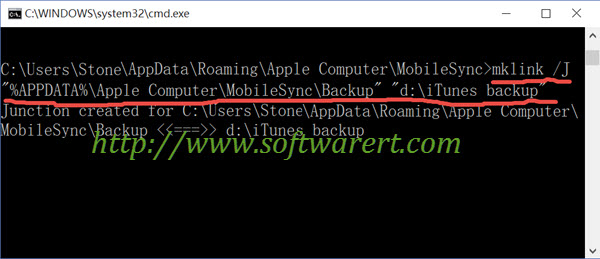iPhone iPad iPod touch users can easily back up iOS devices and content on them to a PC or Mac computer using iTunes. iTunes can back up iPhone iPad iPod in an easy way. When you back up your iPhone or iPad, iTunes will create a full copy of your content from iOS device to computer. These backup files are saved on the system drive as your Windows operating system, usually the C drive. And iTunes backup files are usually very big. What’s worse, many other software will also generate files on your system drive or hard drive. As a result we may need to regularly free up space on our Windows system drive. Otherwise we will run out of space in Windows system partition soon. Unlike other hard drive or files, we can’t move our Windows system files from the system drive to other drive. The only choice we have is to move or delete those app generated data, such as the iTunes backup files, to another hard drive on the PC, such as D drive, E drive and so on. To prevent the same issue happen again, we have to change app data folder for iTunes and other software so they will save data on another location or drive in Windows in the future.

Unfortunately iTunes does not allow users to change where iTunes backup files are stored on computer. In iTunes app, there is no option to alter backup file save location, path or folder. Instead iTunes directly save all iPhone backups, iPad backups and iPod backups to the same back up folder on our Windows system drive. In this article, we will share with you a very easy way to modify the iTunes backup folder location and move iTunes backups files to another drive on Windows PC, or even external drives, like Flash drive, thumb drive, flash stick, external hard drive, portable hard drive and so on. No software or tools required!
How to change iTunes backup location on Windows PC?
There will be merely three simple steps to change iTunes backup files folder to another path, location or hard drive.
Step 1. Create a new iTunes backup folder on another drive
If your Window OS was installed on C drive which is the default system partition, you can go to create a new iTunes backup folder on D drive, E drive or any other drive that is less crowded and has more free storage space. You can also create new iTunes backup folder on Flash drive, thumb drive, flash stick, external hard drive, portable hard drive and so on. You can name the new iTunes backup folder as ‘iTunes backup‘, ‘New iTunes backup‘, ‘iTunes backup new‘, ‘iTunes bak‘, ‘iTunesbackup‘, ‘iTunes-backup‘ or ‘iTunes_backup‘, just make sure it is descriptive and you know it is the folder to save iTunes backup files, iPhone iPad backup files other than the iTunes software itself.
Step 2. Rename old iTunes backup folder on system drive
Where is iTunes backup files stored on Windows computers? In earlier guides, we have showed you how to find iTunes backups in Windows. Check out this guide to find iTunes backup folders in Windows 10. If you have read any of these articles, you should already know the default iTunes backup files path and location. Following are the default iTunes backup folder and path in Windows 10, Windows 8, Windows 7, Vista and Windows XP for your quick reference,
- Windows XP: \Documents and Settings\(username)\Application Data\Apple Computer\MobileSync\Backup\
- Windows Vista, Windows 7, Windows 8, Windows 10: \Users\(username)\AppData\Roaming\Apple Computer\MobileSync\Backup\
Run Windows Explorer on your PC, browse to the iTunes backup folder or iTunes backup files location as listed above. Then rename iTunes backup folder from ‘Backup‘ to anything else, such as ‘Backupold‘, ‘backup old‘, ‘backup-old‘ ‘backup original‘, etc.
Sometimes you may not be able to see AppData in File Explorer or Windows Explorer. It is because this is a hidden folder on Windows computer. You need to change the setting to display the hidden folder.
Step 3. change iTunes backup location on Windows PC
Now we come to the last step to modify iTunes backup location path on a Windows computer. And this is the most technical step, although it is not really difficult.
Background knowledge
In order to change iTunes backup file saving folder or location from system drive to another drive, we need to create a junction from the original iTunes backup folder location. This junction is actually a symbolic link to the actual folder or path. According to Wikipedia, “an NTFS junction point is a symbolic link to a directory that acts as an alias of that directory. This feature of the NTFS file system offers benefits over a Windows shell shortcut (.lnk) file, such as allowing access to files within the directory via Windows Explorer, the Command Prompt, etc.” You can refer to this junction point definition on Wikipedia, or this link about symbolic link in Microsoft Windows system. Note that this is a new feature since Windows Vista.
You may find it is not easy to understand how junction points or symbolic links work on our computer. But you do not really need to know more about that as long as you know how to create a junction point in Windows computer. Do not worry, it is very easy even for beginners.
Once you renamed iTunes backup folder from the original iTunes backup path or location in Windows Explorer, press the SHIFT key on your keyboard, meanwhile right click in the old iTunes backup file location, you will get a pop-up context menu. Select ‘Open command window here‘, you will get a screen like this.

Note that, if you can’t get the above command prompt window somehow, you can click the File menu from top left corner in Windows Explorer, you will get a drop-down menu, then choose Open Command prompt items from this menu to quickly access command prompt in Windows 10, Windows 8, Windows 7 or Vista.
Alternatively you can also go to open the Command Prompt windows in other ways, then use the ‘cd’ DOS command to change directories in a Command Prompt on Windows computer. For example, if you are on Windows 10, you can right click on the Start menu, then choose Command Prompt to quickly launch the command window. By default, the current path in command prompt will be ‘C:\Users\username>‘, you can type in ‘cd AppData\Roaming\Apple Computer\MobileSync\Backup\‘ in the command window then press Enter on your keyboard to change current directory to iTunes backup path.
OK. Now how can we create a junction from old iTunes backup location and relocate iTunes backup path to new drive and folder in command window? ‘mklink /J‘ is the answer. mklink creates a file symbolic link in Windows system. /J refers to the junction point. Here is the sample command line to change iTunes backup file location.
mklink /J “%APPDATA%\Apple Computer\MobileSync\Backup” “D:\iTunes backup”
Type in the above command line and press Enter to execute, you will get a response message saying the junction link has been created in Windows Command Prompt. Note that D drive is the new drive to save iTunes backup files in the future. ‘iTunes backup’ is the new iTunes backup folder on another location other than the original one on the Windows system drive. So you will create a new iTunes backup folder on a different hard drive on computer. Check out below screenshot.

Congratulations! You have successfully modified the default iTunes backup file path. The old iTunes backup folder has been relocated to another drive on the computer. Any iPhone, iPad, iPod backups via iTunes will be saved to the new folder on new disk drive on your computer.
Now you can go to delete old iTunes backup files on computer to free up space in Windows system drive, or you can go to move iTunes backups to another folder or hard drive on computer before you delete them. If you like to do so, check out steps below.
How to move iTunes backup files to another folder or drive on computer?
Now open Windows Explorer on your PC, browse to the old iTunes backup folder, copy the existing iPhone backup file, iPad backup file or iPod touch back file, and paste them to the new iTunes backup folder on another disk drive, it is the ‘D:\iTunes backup‘ in the above demo.

Invalid switch – itunes
above error occurs
Don’t Copy and Paste…
Use ” instead of what’s shown.
Is the site open for advertising? please tell me how to contact the site, thanks
iTunes let me set D: drive as location for library. That was simple.
This has more to do. Could it not be done as simply?
This was really helpful and easy to do (even though I am not technologically inclined whatsoever). When I tried to back up my iPhone through iTunes though, it told me that it could not backup my iPhone because “the backup was corrupt or not compatible.” It then says to delete the backup for this iPhone in Devices Preferences and try again…. but when I open devices preferences there is no backup to delete (I have not backed up to this computer at all yet as I do not have enough storage). Need help!
except backing up iPhone to a different hard drive on the computer, we can also backup iPhone to a flash drive or portable hard drive when our computer does not have enough storage space.